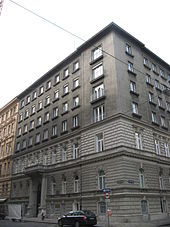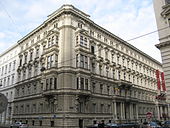Wilhelm Stiassny
Wilhelm Stiassny (* 15. October 1842 in Bratislava ; † 11. July 1910 in Bad Ischl ) was in Vienna active Jewish architect , co-founder of the Wiener Bauhütte , Vienna municipal and city council, as well as an active member of the Jewish Community . His main works are residential and commercial buildings and social buildings, his synagogues built in the Moorish style are particularly well known .
Life


Wilhelm Stiassny was born as the eldest son of the businessman Abraham Stiassny and his wife Josefine, née Breslauer, in Pressburg, now Bratislava. When he was four years old, the family moved to Vienna, where they lived in the “textile district”. From 1848 Stiassny first attended the Leopoldstadt parish and secondary school, then the secondary school in Heiligenkreuzerhof and then the lower and upper secondary school, also in downtown Vienna . From 1857 to 1861 he studied higher mathematics, physics, descriptive geometry, mechanics, practical geometry, agriculture, hydraulic engineering and drawings at the kk Polytechnic Institute in Vienna . In October 1861 he entered the Academy of Fine Arts , where he studied with Eduard van der Nüll , Carl Roesner , Friedrich von Schmidt and August Sicard von Sicardsburg until 1866 . In 1862, together with fellow students, he founded the Wiener Bauhütte , an association of students at the academy, which almost all Viennese architects later joined. In February 1864 he was accepted as a member of the Austrian Association of Engineers and Architects.
After completing his studies, Stiassny took part in the installation work at the World Exhibition in Paris in 1867 as a delegate of the Austrian Commission , where he was a member of the international jury for workers' houses, a topic that occupied him from then on and in 1868 led to the establishment of the Viennese non-profit construction company, which was the forerunner the social building movement applies.
After five years in Friedrich von Schmidt's studio and several study trips, Stiassny settled in Vienna as a freelance architect in 1868. In the same year he married Julia Taussig, an educated Hungarian Jew from Székesfehérvár , who promoted her husband's career with her Vienna salon. Their only son Sigmund was born in 1873. Stiassny was soon one of the most sought-after architects in Vienna and employed several people, such as Ignaz Reiser (1863–1940), who was particularly involved in the construction of synagogues.
In the years from 1878 to 1900 and from 1904 to 1910, Stiassny was a representative of the Liberals on the Vienna City Council, where he mainly dealt with issues of architecture and urban planning and also had to fight against burgeoning anti-Semitism . In 1894, he was sentenced to twelve hours of arrest in an anti-Semitic local council initiated by an anti-Semitic council, a sentence that was confirmed in the second instance, but converted into a fine of 50 guilders. From 1894 to 1895 Stiassny was also a city councilor in Vienna, but had to give up this office because of the anti-Semitism of Karl Lueger's Christian Social Party .
From 1879 until his death, Stiassny was a member of the board of the Israelitische Kultusgemeinde Wien, where he took care of construction, among other things. He was also a founding member of the Viennese Lodge des B'nai B'rith and founded several associations to support the Jewish population in Vienna. At the beginning of February 1895 the Society for the Collection and Conservation of Art and Historical Monuments of Judaism was founded, and Stiassny was elected President. On November 1st of the same year the world's first Jewish museum of its kind was opened at Rathausstrasse 13 in Vienna. The house was built by Stiassny for his wife in 1881–1882 and served the family as a residence until 1901 and Stiassny as a studio.
Stiassny had been in contact with Theodor Herzl , the founder of political Zionism , at least since 1895 . In 1904 the Jewish Colonization Association in Vienna was founded, whose president Stiassny was until his death and whose official colonization project he worked on: a 54-page publication divided into the chapters Geography of Palestine, Population, Trade, Industry, Transport, Colonization, The Jewish Colonies, Our colony and political, financial, which was the first to give a detailed account of plans for Jewish settlements in Palestine . In addition, Stiassny also drafted a plan for the future city of Tel Aviv without ever having been to Palestine.
In 1883 Stiassny was awarded the title of kk building officer, ten years later he received tax-free citizenship of the city of Vienna, and in 1903 he was awarded the Officer's Cross of the Franz Josef Order. 1900–1901 Stiassny built a house in downtown Vienna at Krugerstraße 8, where he lived and worked from 1901 until his death. He died on July 11, 1910 during a spa stay in Bad Ischl and was buried on July 14 in the Vienna Central Cemetery.
plant
Stiassny was one of the busiest architects of his time. He built around 170 residential and commercial buildings, factories, schools, hospitals, twelve neo-Moorish and neo-Romanesque synagogues, as well as cemetery structures, mostly for Jewish clients.
- 1870–1875 Rothschild Hospital in Vienna-Währing
- 1871–1872 Israelite Institute for the Blind in Vienna-Döbling
- 1871–1872 Palais Schwab in Vienna's inner city
- 1874–1875 House Doblhoffgasse 3 , Vienna city center (Rathausviertel)
- 1877–1879 Ceremonial hall in the Vienna Central Cemetery , Israelite Department, 1st gate
- 1881–82 Stiassny residential building (Rathausstrasse 13), downtown Vienna (Rathausviertel) - partially destroyed in World War II
- 1881–82 Synagogue in Teplitz - destroyed in March 1939
- 1882 Königswarter House (Rathausstrasse 15–17), downtown Vienna (Rathausviertel)
- 1887 Synagogue in Malacky - almost completely destroyed by lightning in 1899 and rebuilt by 1900
- 1888 House Lichtenfelsgasse 7 , downtown Vienna (one of the arcade houses in the Rathausviertel)
- 1891–1892 Synagogue in Gablonz - destroyed in November 1938
- 1892–1893 Synagogue Leopoldsgasse (Polish school) in Vienna-Leopoldstadt - devastated November 1938, demolished between 1959 and 1960
- 1894–1899 Stanisławów Temple , Galicia (today Ivano-Frankivsk, Ukraine)
- 1897–1899 synagogue in Čáslav
- 1899–1903 Emperor Franz Josef's anniversary hospice for poor Israelites in Karlsbad
- 1901–1902 synagogue in Wiener Neustadt
- 1904–1906 Jubilee Synagogue (today the Jerusalem Synagogue) in Prague
- Grave monuments, including the crypt for members of the Viennese branch of the Rothschild family at the central cemetery
Synagogues
Synagogue in Malacky , built in 1887, almost completely destroyed in 1899 and rebuilt by 1900
Synagoge Leopoldsgasse, from: Allgemeine Bauzeitung 1894
literature
- Constantin von Wurzbach : Stiaßny, Wilhelm . In: Biographisches Lexikon des Kaiserthums Oesterreich . 38th part. Kaiserlich-Königliche Hof- und Staatsdruckerei, Vienna 1879, pp. 334–336 ( digitized version ).
- Felix Czeike : Historisches Lexikon Wien , Volume 5. Kremayr & Scheriau, Vienna 1997, ISBN 3-218-00547-7 , p. 345.
- W. Krause: Stiassny Wilhelm. In: Austrian Biographical Lexicon 1815–1950 (ÖBL). Volume 13, Verlag der Österreichischen Akademie der Wissenschaften, Vienna 2007–2010, ISBN 978-3-7001-6963-5 , p. 246 f. (Direct links on p. 246 , p. 247 ).
- Inge Scheidl u. a .: Wilhelm Stiassny (1842-1910). Jewish architect and city politician in the social tensions of the Viennese fin de siècle , Vienna a. a .: Böhlau 2019 ISBN 978-3-205-23172-1 .
- Satoko Tanaka: Wilhelm Stiassny (1842-1910) . Dissertation, Faculty of History and Cultural Studies at the University of Vienna, 2009. ( online version )
Web links
- Wilhelm Stiassny. In: Architects Lexicon Vienna 1770–1945. Published by the Architekturzentrum Wien . Vienna 2007.
- Entry on Wilhelm Stiassny in the Austria Forum (in the AEIOU Austria Lexicon )
- Ursula Prokop: Wilhelm Stiassny (1842–1910) architect - councilor - Zionist David, Jewish cultural magazine issue 81
- Wilhelm Stiassny and the development plan for Tel Aviv (1909)
- Entry in the Jewish Encyclopedia (English)
Individual evidence
- ↑ Entry in the birth register in the Israelite congregation in Pressburg ; Entry No. 266, the date of birth is not October 15th but October 14th and the name of the person born is not Wilhelm, but "Philipp", the father's name is written as "Styassny Abraham"
- ↑ Place of birth and dates of life are given differently. The Jewish Encyclopedia names Vienna as the place of birth, the Vienna Lexicon by Felix Czeike as the date of birth December 15, and the date of death is also mentioned as June 16. In her dissertation on Stiassny, Satoko Tanaka gives plausible arguments for the dates of life from October 15, 1842 to July 11, 1910. Satoko Tanaka: Wilhelm Stiassny (1842–1910). Synagogue building, orientalism and Jewish identity . Dissertation Univ. Vienna. Vienna 2009, p. 16 ( Online (PDF; 9.1 MB)).
- ↑ Tanaka 2009 (PDF; 9.1 MB), pp. 16-19
- ↑ Tanaka 2009 (PDF; 9.1 MB), pp. 16-20
- ↑ Tanaka 2009 (PDF; 9.1 MB), pp. 20f
- ↑ Tanaka 2009 (PDF; 9.1 MB), p. 16
- ↑ Tanaka 2009 (PDF; 9.1 MB), pp. 20f.
- ↑ Tanaka 2009 (PDF; 9.1 MB), pp. 32–37
- ↑ Tanaka 2009 (PDF; 9.1 MB), p. 21f.
- ↑ Tanaka 2009 (PDF; 9.1 MB), pp. 137–140
- ↑ Tanaka 2009 (PDF; 9.1 MB), pp. 146–156
- ↑ Tanaka 2009 (PDF; 9.1 MB), p. 22
- ^ Synagogue Teplitz (accessed on August 23, 2018)
- ↑ Tanaka 2009 (PDF; 9.1 MB)
- ↑ Joshua Shanes: Ivano-Frankivsk . In: Gershon David Hundert (Ed.): The YIVO Encyclopedia of Jews in Eastern Europe . tape 1 . Yale University Press, 2008, ISBN 978-0-300-11903-9 ( online ).
- ^ Bob Martens, Herbert Peter: The Destroyed Synagogues of Vienna. Virtual City Walks . LIT Verlag, Münster 2012, ISBN 978-3-643-90170-5 , p. 51-60 ( Online: Google Books ).
| personal data | |
|---|---|
| SURNAME | Stiassny, Wilhelm |
| BRIEF DESCRIPTION | Austrian architect |
| DATE OF BIRTH | October 15, 1842 |
| PLACE OF BIRTH | Pressburg |
| DATE OF DEATH | June 16, 1910 |
| Place of death | Bad Ischl |








